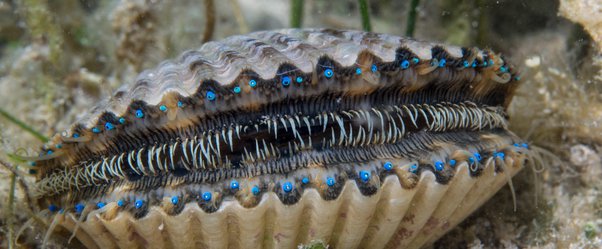
One of the world’s best-known Renaissance works of art is Sandro Botticelli’s The Birth of Venus. It features the beautiful Venus, the Roman Goddess of Love, carried ashore on a giant scallop shell. Art historians explain that through the ages, scallops and other hinged shells have symbolized what they call the feminine principle and fertility.
The scallop shell turns up in some very unexpected places. The Louvre Museum in Paris has on display a sculpture of Aphrodite in a scallop shell. The Scallop shell was a popular emblem for pilgrims on the Way of St James going to the apostle’s shrine in Spain. A scallop appears on Winston Churchill’s coat of arms and the scallop shell is the worldwide logo of the Shell Petroleum Company.
However, there is more to the scallop than its rich history in art, poetry and heraldry. The scallop is a very special marine bivalve mollusk. They are of the family Pectinidae. There are 300 living species, and they are found in oceans all over the world. There are approximately 7000 fossil species and subspecies.

Scallops have some unique advantages over their cousins like clams, oysters and other mollusks. The scallop can swim by clapping their valves together and shooting out a jet of water. This jet of water allows them to scoot away from a predator. Once the scallop breaks free of the byssal anchors, a sort of anchor line created by young scallops, by either swimming free or by the weight of the shell, the scallops lay free on the ocean floor. Normally the scallop lies on the bottom with the flat valve uppermost and the convex valve beneath. This allows the opening water intake to be well clear of the sandy it could draw up. When scallops swim the hinge part is at the rear and the free margin of the shell face forward. During an emergency escape, probably from the attack of a starfish, the scallop swims in the opposite direction. Certainly, one of the most impressive feats of the scallop is its swimming ability. The adductor muscle in the scallop is similar to but larger than the muscle in an oyster. Any sudden ejection of water from between its valves will cause it to move hinge forward. While at the same time the edges are muscular and can for themselves into the nozzle of a jet anywhere around the margin. This gives the scallop control over the direction it takes. Scallops have three distinct kinds of movement they can perform, normal swimming, twisting and the escape movement.
Perhaps even more surprising is the scallop’s ability to see. Scallops have eyes around the edges of their mantle. While they cannot see shapes they can detect changes in light patterns, motion, and shapes. The approximately 200 blue eyes on the fringe of the shell can let the scallop know there is movement. Each eye has a lens, a retina and an optic nerve. It is doubtful they can actually perceive images but they can definitely recognize light.
The ridged shape of the shell half allows them to clamp together closely. Interestingly, at some stage in their lives, all scallops have a ridge of tiny teeth near the notch where the byssus comes out in other bivalves. Scallops produce and secrete specialized adhesives that work synergistically in water allowing them to attach themselves in marine environments. The secreted adhesive proteins solidified in seawater and shaped into byssus with excellent flexibility and toughness.
In the US we rarely see scallops in the shell. In Europe, they are displayed shucked and in the shell with the orange sexual organs attached. Some species of scallop have only one sex. They are male or female while other species are hermaphrodite’s and may have both male and female reproductive organs. Some scallops are males when they are young and then become female as they age. When scallop larvae are first released it drifts among the plankton then eventually to the bottom again to grow attaching their byssal threads to other objects.
Scallops have been around for at least 200 million years. Perhaps because of the excellent defense system against their arch enemy the starfish. The scallop’s highly developed sense organs along with the eyes around the mantle margin warn of dangers. It is believed the tentacles that protrude from the scallop have a sense of smell, particularly the smell of a starfish.
Obviously, scallops are a mainstay of shellfish eaten around the world. Maurice Edmond Sailland, better known by his pen-name Curnonsky (nicknamed ‘Cur’), and dubbed the Prince of Gastronomy, was a celebrated writer on gastronomy in France in the 20th century. He wrote or ghost-wrote over 65 books and enormous numbers of newspaper columns. He is often considered the inventor of gastronomic motor-tourism as popularized by Michelin, though he himself could not drive. Curnonsky describes the scallop thusly; “Their plump bodies, white as a mother of pearl, their roes shaped like scarlet beans containing the eggs, when simply scalded or poached have a delicate taste of incomparable subtlety. As a treat, they vie with lobster and particularly crawfish, which are tough and tougher than the tender flesh fragrant with marine flavors that hides between the valve of a scallop, to the surprise and joy of gourmets. For this reason, no restaurant in Paris or the French provinces forgoes the honor of including on its menu scallop prepared according to its own recipe.”
The scallop shell is unique in its symmetrical shape and neatness. Compared to the clam and oyster, it is incredibly beautiful. Here is to the mighty scallop praised in this poem by Dora Sigerson Shorter.
The Scallop Shell
A scallop shell, loosed by the lifting tide,
Had left a friendly shore, the seas to brave;
Its lips of pink and snowy hollow shone
Pure in the sun, a pearl upon the wave.
It gleamed and passed-you burdened it with love,
With sweet long futures, new and dreamy days:
And named for me-because I held your hopes.
I bid you hush-not meriting your praise.
I pointed, where your vessel came to shore,
Wrecked where the tiny breakers rose and fell;
And bid your voyagers not put to sea
So fail a craft as this poor scallop shell.
To truly appreciate the culinary joy of the scallop, there is nothing better than to try one of Julia Child’s favorites, COQUILLES SAINT JACQUES.
